| Article ID | Journal | Published Year | Pages | File Type |
|---|---|---|---|---|
| 1057031 | Journal of Environmental Management | 2012 | 6 Pages |
An experimental design methodology was applied to study the effects of temperature, pH, biomass dose, and stirring speed on copper removal from aqueous solutions by Aspergillus terreus in a biosorption batch system. To identify the effects of the main factors and their interactions on copper removal efficiency and to optimize the process, a full 24 factorial design with central points was performed. Four factors were studied at two levels, including stirring speed (50–150 min−1), temperature (30–50 °C), pH (4–6) and biosorbent dose (0.01–0.175 g). The main factors observed were pH and biomass dose, along with the interactions between pH and biomass, and stirring speed. The optimal operational conditions were obtained using a response surface methodology. The adequacy of the proposed model at 99% confidence level was confirmed by its high adjusted linear coefficient of determination (RAdj2=0.9452). The best conditions for copper biosorption in the present study were: pH 6, biosorbent dose of 0.175 g, stirring speed of 50 min−1 and temperature of 50 °C. Under these conditions, the maximum predicted copper removal efficiency was 68.52% (adsorption capacity of 15.24 mg/g). The difference between the experimental and predicted copper removal efficiency at the optimal conditions was 4.8%, which implies that the model represented very well the experimental data.
